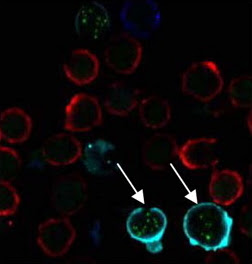
Antibodies and Methods for the Diagnosis and Treatment of Epstein-Barr Virus Infection
The green dots show Epstein-Barr virus inside B cells (blue circles) but not T cells (red circles). Credit: NIAID
NIAID researchers are developing neutralizing antibodies, originally isolated from humans or nonhuman primates, that could be useful in preventing primary infection or reactivation of Epstein-Barr virus (EBV) in immunocompromised individuals. Currently, there is no prophylactic to prevent primary EBV infection, and additional therapeutics would be useful to treat EBV-associated B-cell driven lymphoproliferative disease.
The available antibodies are 10 to 100 times more potent than the most potent EBV neutralizing antibody identified to date (72A1). The antibodies target epitopes on either the gp350 surface glycoprotein of EBV or the gH/gL heterodimer. In vitro experiments have demonstrated that the antibodies effectively inhibit EBV infection of B cells and epithelial cells as well as cell-to-cell fusion of cells expressing the viral proteins gH/gL. Read more about this exciting collaboration opportunity: https://www.ott.nih.gov/






















.png)












No hay comentarios:
Publicar un comentario